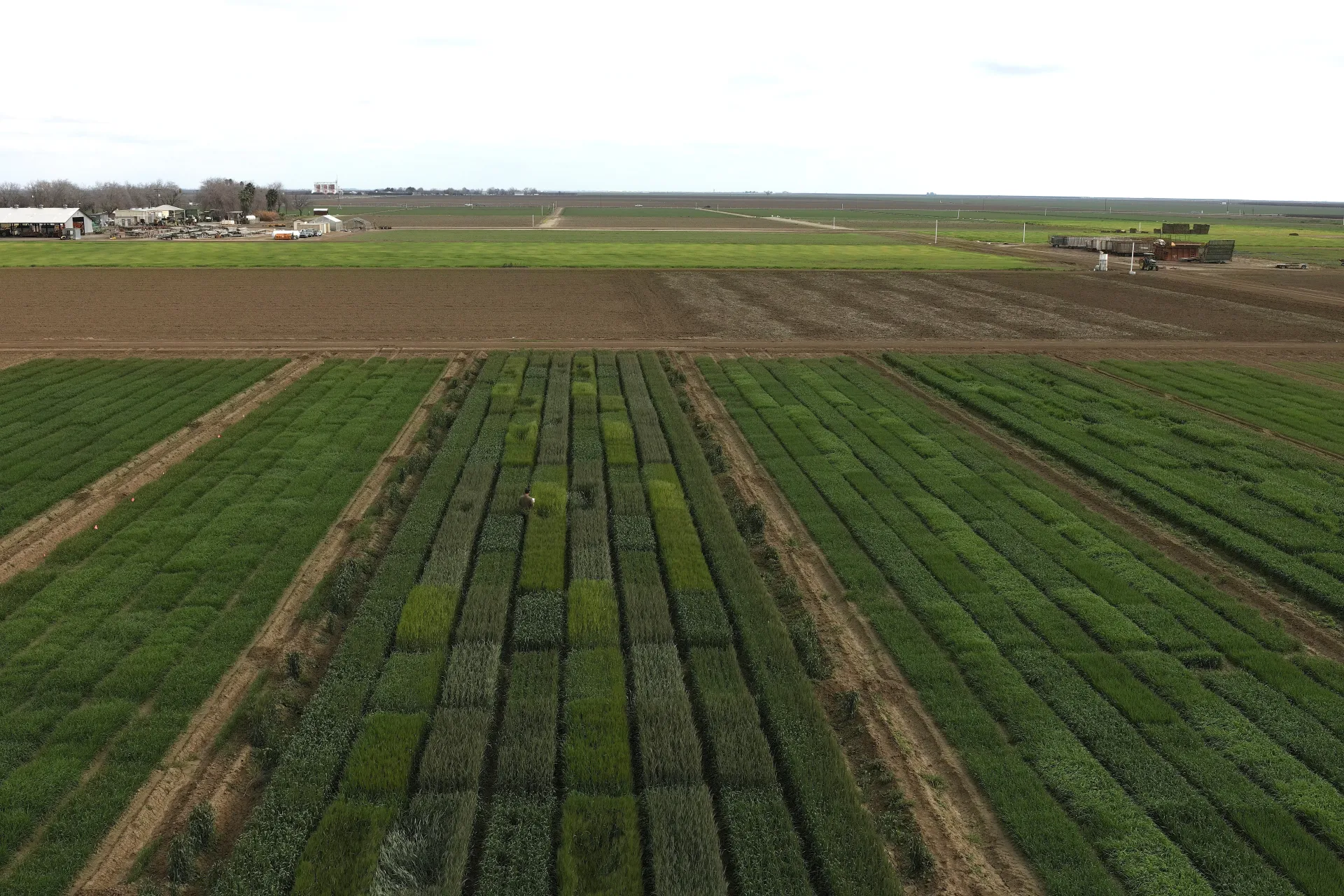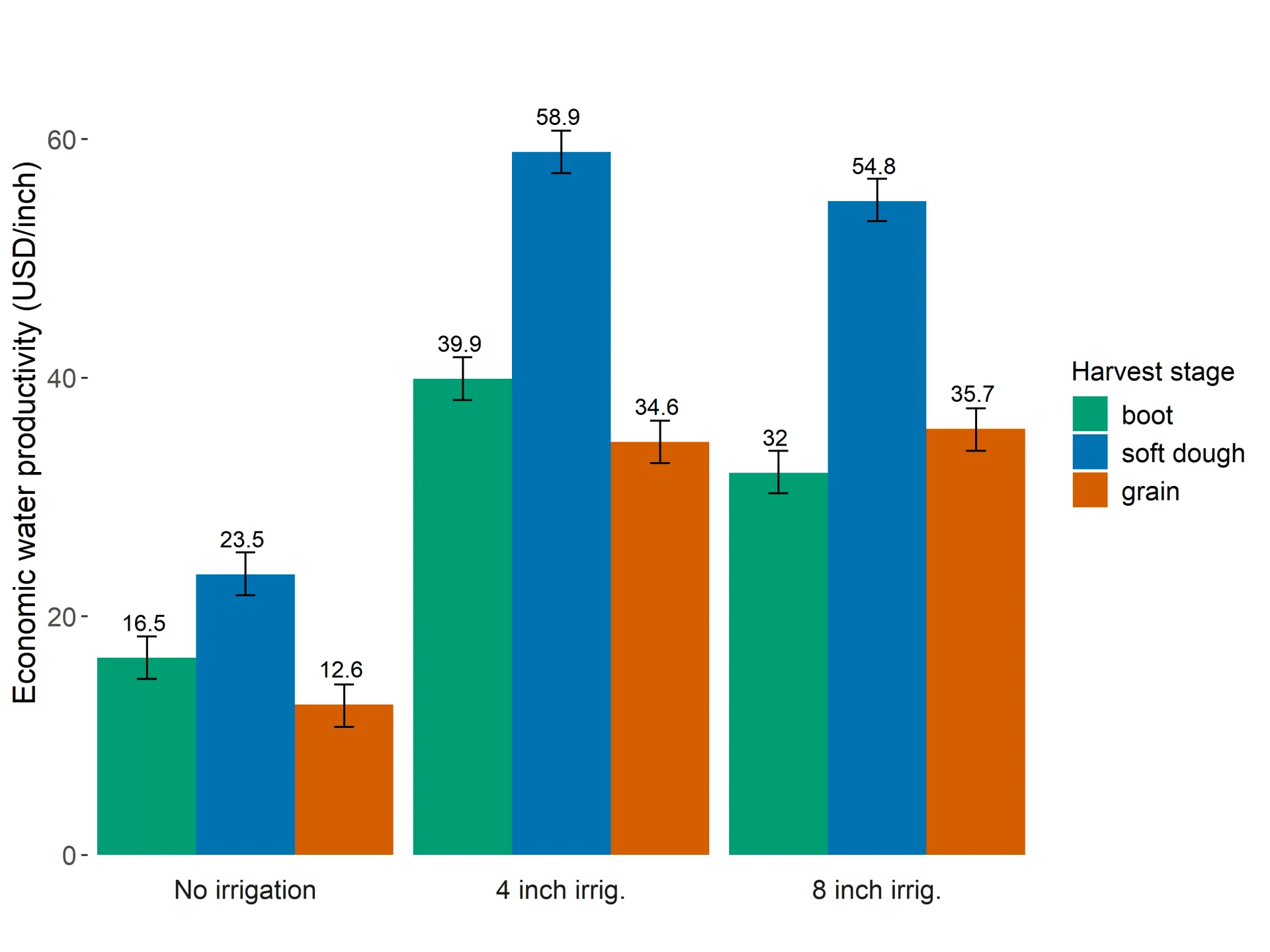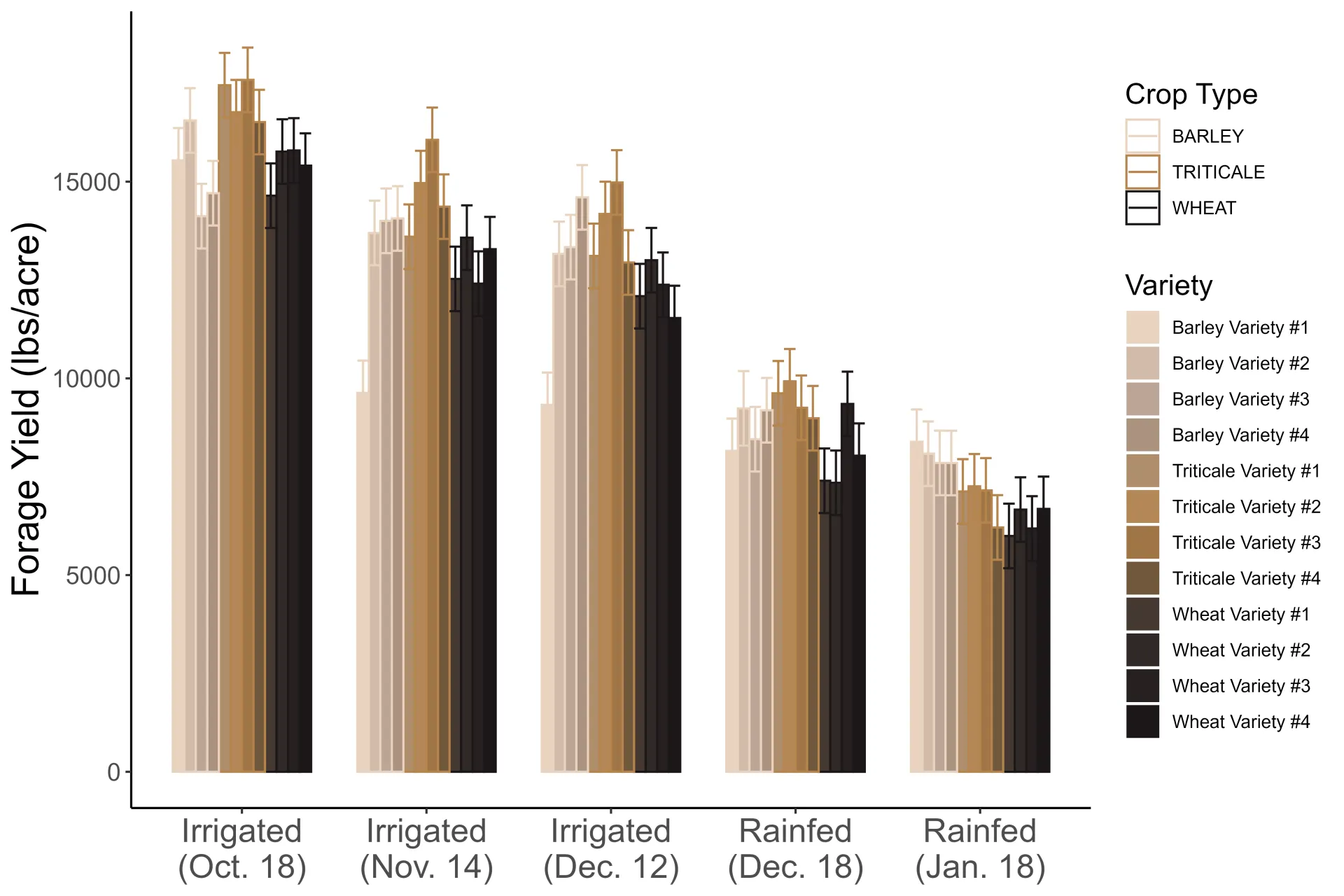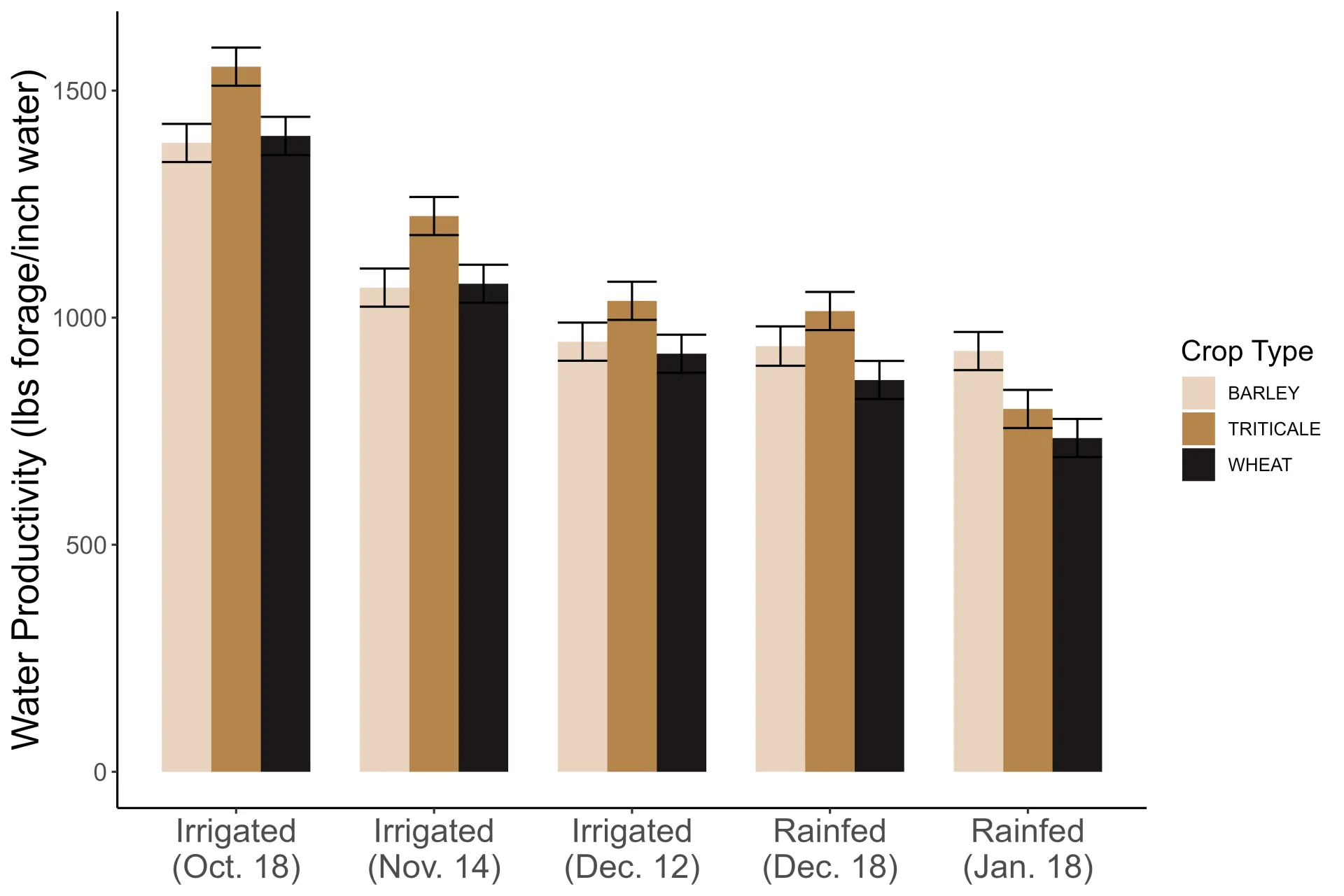Water productivity of winter cereal crops in the San Joaquin Valley: Research update
Authors: Maya Shydlowski, Caitlin Peterson, Josh Hegarty, Mark Lundy
---
Over 500,000 acres of farmland in California are expected to come out of production by 2040 because of water limitations from drought and state regulations. While some of this land may be put to other uses, much of this acreage could be left fallow (Ref. 1). Finding ways to keep growing crops even when water is limited would help farmers, protect the environment, and support the economy (Ref. 2). Winter cereals such as wheat, barley, and triticale could be a part of the solution. These crops are low maintenance and offer growers options for flexible management. They can be grown with little water input, relying mostly on precipitation from the winter rains, and can be harvested for a range of forage and grain products. In some parts of California, winter cereals are grown without any irrigation, but rainfall in the San Joaquin Valley is unpredictable and typically lower than the state average, making dryland agriculture more difficult (Ref. 2).
Our current research explores ways to maximize the productivity of winter cereal crops with as little water input as possible. Specifically, we ask how crop choice, timing of planting, and small amounts of irrigation impact water productivity under water-limited scenarios in the San Joaquin Valley.

To study this, we first used a computer-based crop model to estimate forage and grain yield of winter cereal crops under various irrigation and rainfall amounts (Ref. 3). This research showed that without irrigation, winter cereal crops in the San Joaquin Valley would fail in most years, but that applying four to eight inches of water early in the season would likely lead to a financially viable crop across much of the valley in most years. The results also showed that harvesting winter cereals as a forage crop near the soft dough growth stage led to the greatest economic return per unit of available water (Figure 1). Additionally, planting earlier in the season (~mid-October) resulted in better water efficiency when some irrigation was applied, while planting later (~mid-December) worked better without irrigation.

An ongoing research trial is building on these results, testing them out in the field to better understand how planting timing and pinpointed irrigation applications affect forage and grain productivity across varieties of wheat, barley, and triticale. During the past two seasons, we have planted trials in Five Points, CA (western Fresno County), with different combinations of planting dates and water levels. Management combinations during the 2023-24 season included:
- Irrigated at planting, October planting (10/18/2023)
- Irrigated at planting, November planting (11/14/2023)
- Irrigated at planting, December planting (12/12/2023)
- Rainfed, December planting (12/18/2023)
- Rainfed, January planting (1/18/2024)
For each environment with irrigation, four inches were applied immediately after planting (“establishment irrigation”) and no further irrigation was applied.
In each management setup, we grew four varieties each of wheat, barley, and triticale, and harvested them for both forage and grain.
While our 2024-25 trial is ongoing, results from the 2023-24 season have already produced some interesting insights. For context, Five Points experienced above-average rainfall during the 2023–24 water-year. Between October 2023 and June 2024, the area received 8.8 inches of rain—116% of the ten-year average of 7.6 inches for the same period at that location.
Our forage harvests occurred when crops had entered the soft dough growth stage. In this first year of the two-year study, we found that an earlier planting date (Oct. 18) resulted in higher forage yields under establishment irrigation (Figure 2). This is probably a result of the ability of the plants grown in these fields to take advantage of the warmer weather and early rain at critical stages of early plant growth. This was the opposite pattern of what we saw for grain yields, which were higher for the December planting date (data not shown). Also, the interactions among crop types and varieties were more complex for grain yields than for forage yields.

With establishment irrigation, triticale had the highest forage yields, while both barley and triticale had forage yields higher than wheat under rainfed conditions. Importantly, the 2023-24 results emphasized that variety selection matters. Although there were some crop-type differences, individual varieties responded in unique ways to the different management strategies. For example, one of the barley varieties (#1, Figure 2) had similar yields to the other barley varieties under rainfed conditions and with establishment irrigation for the October planting date. However, under establishment irrigation with November and December planting dates, the same variety had significantly lower forage yields than the other barley varieties. Grain yields also showed large differences among varieties within each crop type.

When considering water productivity, or pounds of forage per inch of water available to the crop (irrigation + rainfall + soil water in the root zone), we found that an earlier planting date resulted in higher water productivity under both establishment irrigation and rainfed conditions (Figure 3). Under establishment irrigation, triticale had the highest water productivity compared to wheat and barley for both forage and grain crops, a pattern that matched the yield results. Without any irrigation, barley tended to have higher water productivity than wheat but did not differ much from triticale.
Other water productivity results did not always match the yield data. Overall, yields were much higher with establishment irrigation, and, on average, water productivity was higher with establishment irrigation than in the rainfed treatments. One exception to this was the irrigated field with a December planting date, which had comparable water productivity to the rainfed field with a December planting date.
We are continuing the second year of this experiment in the current 2024-25 field season with similar management scenarios. The 2024-25 season has been drier, with precipitation more than 20% below average. These conditions may result in different patterns than what we measured in the first year. Regardless, some conclusions that we are confident about from the work completed so far: 1) In a low water year, a purely rainfed crop is unlikely to be economically viable in much of the San Joaquin Valley; 2) Early planting with establishment irrigation provides the greatest range of options for producing either forage or grain crops with limited water availability; and 3) Variety selection—not just crop type—is an important factor for successfully navigating water limitations in winter cereal production.
References:
